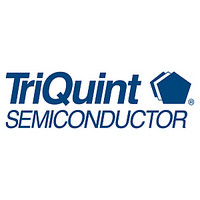AP501-PCB TriQuint, AP501-PCB Datasheet - Page 3

AP501-PCB
Manufacturer Part Number
AP501-PCB
Description
RF Modules & Development Tools 1.93-1.99GHz Brd 12V 4W 3-stage
Manufacturer
TriQuint
Datasheet
1.AP501-PCB.pdf
(5 pages)
Specifications of AP501-PCB
Minimum Frequency
1.93 GHz
Minimum Operating Temperature
- 40 C
Supply Voltage (min)
5 V
Product
RF Development Tools
Maximum Frequency
1.99 GHz
Supply Voltage (max)
12 V
Supply Current
840 mA
Maximum Operating Temperature
+ 85 C
Lead Free Status / RoHS Status
Lead free / RoHS Compliant
WJ Communications, Inc • Phone 1-800-WJ1-4401 • FAX: 408-577-6621 • e-mail: sales@wj.com • Web site: www.wj.com, www.TriQuint.com
The AP501 can be adjusted to operate at lower current biasing levels by modifying the R7 resistor for improved efficiency
performance. The configuration shown on this page has the AP501 operating with Icq = 250 mA (Icc = 400 mA @ 27 dBm).
Output L-C matching components have been added externally on the circuit to optimize the amplifier for ACPR performance at
this biasing configuration.
RF IN
31
30
29
28
27
26
-40
-50
-60
-70
1930
25
+25 °C, IS-95A, 9 Ch. Fwd, 1FA, fo=1960 MHz, Icq=250mA
AP501
PCS-band 4W HBT Amplifier Module
±885 kHz
±1.25 MHz
DNP
Narrowband S-Parameters
26
Output Channel Power (dBm)
1950
ACPR vs. Channel Power
Frequency (MHz)
0Ω
+25 °C, Icq=250mA
27
DNP
DNP
28
DNP
1970
0Ω
Performance Graphs – Class B Configuration
29
S21
S11
S22
DNP
1990
6
30
100pF
.01μF
0
-5
-10
-15
-20
-25
5
31
4
3
500
400
300
200
100
-40
-50
-60
-70
730Ω
2
0
18
24
DNP
DNP
1
+25 °C, IS-95A, 9 Ch. Fwd, 7FA, fo=1935 MHz, Icq=250mA
±885 kHz
±1.25 MHz
19
Icc
25
PAE / Icc vs. Output Power
Output Channel Power (dBm)
Output Power (dBm)
ACPR vs. Channel Power
10μF
+25 °C, 1960 MHz, Icq=250mA
26
20
PAE
DNP
27
21
2.2nH
100pF
.01μF
28
22
29
23
RF OUT
R2
0.2pF
30
24
50%
40%
30%
20%
10%
0%
25
Notes:
1. Please note that for reliable operation, the evaluation board will have to
2. The area around the module underneath the PCB should not contain any
3. For proper and safe operation in the laboratory, the power-on sequencing
Specifications and information are subject to change without notice
be mounted to a much larger heat sink during operation and in laboratory
environments to dissipate the power consumed by the device. The use of
a convection fan is also recommended in laboratory environments.
Details of the mounting holes used in the WJ heatsink are given on the
last page of this datasheet.
soldermask in order to maintain good RF grounding.
should be followed:
a. Connect RF In and Out
b. Connect the voltages and ground pins as shown in the circuit.
c. Apply the RF signal
d. Power down with the reverse sequence
-20
-30
-40
-50
-60
-70
-40
-50
-60
-70
22
20
+25 °C, 3GPP W-CDMA, Test Model 1+32 DPCH, 1960 MHz, Icq=250mA
±5 MHz
±10 MHz
21
OIP3 / IMD vs. Output Power
Output Power / tone (dBm)
Output Channel Power (dBm)
24
22
ACLR vs. Channel Power
+25 °C, 1960 MHz, Icq=250mA
Product Information
23
26
IMD
24
25
Page 3 of 5 July 2008
28
OIP3
26
30
27
55
50
45
40
35
30
28






